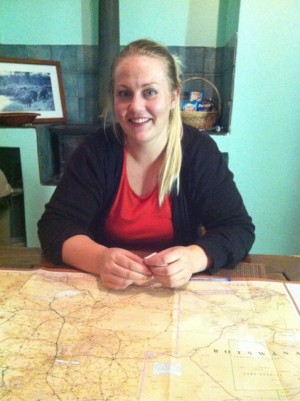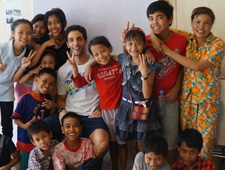The people of Namibia were. . . .wait, what people? The country’s vast and harsh landscape is inhabited by only around 2.3 million people, making it one of the least densely populated countries on the planet. Yet, although the population is small, the eclecticism and diversity of its people are quite large. With more than eleven ethnic tribes, and a history that includes German colonization (1884-1915) and apartheid influence from its Afrikaner neighbors in South Africa (Namibia gained independence from South Africa in 1990), the people of Namibia were very interesting to learn about.
Name: Corinna
Age: 29
Occupation: Tour consultant for Africa Tourist Info
Hometown: Windhoek
Although we met Corinna for less than 24 hours, she gave us a great sense and introduction into Namibia and it’s people. After communicating via email for our 4×4 vehicle rental, we finally met Corinna in person. Once she secured us a vehicle and mapped out a spectacular 12-day journey through her native country, Corinna took the time to explain to us the people of Namibia: black people, German whites, and Afrikaners (African white people with Dutch heritage). It was here in Namibia where Kat and I gained our first experience and witnessed the past Apartheid influence and the lingering segregation of whites and blacks. Even though white people are the minority, it felt to us like they were the overwhelming majority.
I asked Corinna what it was like growing up in Namibia as a white child from German parents. Having gone to a private German school growing up, 80-90% of her friends were white. She told me that in general, the lives of whites and blacks are quite different and quite separate. She went on to explain that there is no racist connotation to this, but just a fact that they think differently, live differently, eat different foods, and have an overall different view on life. In regards to the unique mix of culture, it was the norm to have the German influence in her life. And it was an automatic bonus speaking three languages at a very young age – German, Afrikaans, and English (Namibia’s official language). As outsiders, Kat and I naively assumed that all of the white people in Namibia were German or Afrikaner. It was enlightening to realize that many white Namibians are born and bred in the country.
Speaking with Corinna gave us a quick background and understanding of Namibia and it’s people. As a native who has also spent time in Germany, London, and South Africa, Corinna takes pride in calling Namibia home. There is a lot of hope for her homeland and she can’t wait to see it become more up and coming. Read below to see a few more comments from my conversation with Corinna:
What three words best describe the people of Namibia?
- Social – a lot of people like to meet up after work during the week. On occasion, people also like to go camping with a group on the weekends to get close to nature and be reminded of the beauty of our country.
- Multi-cultural – we have many different tribes and, of course, a lot of German expats.
- Nature-friendly
What three words best describe Namibia?
- Massive
- Contrasting – we have such a widely varied landscape.
- Dry – sometimes a lack of rain and water can force us to shoot some of the animals because there isn’t enough grass to feed everyone.
What is the top priority of the people of Namibia?
Right now, I think rain is the top priority in Namibia! We need more rain to see a positive future and I think that counts all over the country and will benefit people as well as animals.
How do people typically make a living?
Agriculture is at the top and maize for food is the highest for sure. Tourism is definitely playing a role. There was a dip with the recession a year ago, but booking levels are increasing. A lot of people also create jobs by selling stuff on the side of the road – curios, beading and wiring. You might see one guy walking around selling fluffy socks and another guy selling sunflowers. Whatever they can do to make money they will. Some tribes are lazier than others.
What is your favorite place to visit?
Damaraland – it provides a sense of peace and serenity. It’s an amazing getaway from the city (Windhoek). The people there are very environmentally friendly. Due to conservation efforts, drivers aren’t allowed to go off the main road so it has maintained it’s natural beauty.






Surprised that the German colonization isn’t still an issue; it was pretty ugly;
“From 1904 to 1907, the Herero and the Namaqua took up arms against the Germans and in the subsequent Herero and Namaqua genocide, 10,000 Nama (half the population) and approximately 65,000 Hereros (about 80% of the population) were killed. The survivors, when finally released from detention, were subjected to a policy of dispossession, deportation, forced labour, racial segregation and discrimination in a system that in many ways anticipated apartheid.”
Source: http://en.wikipedia.org/wiki/Namibia
Even most of the native population is Lutheran.
Of course, the rule by South Africa was pretty bad too.